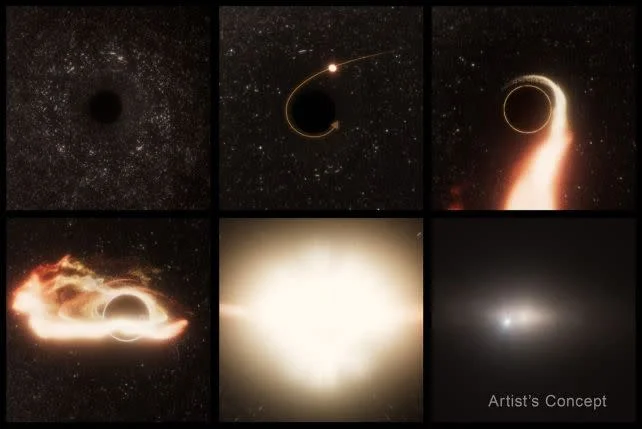
NASA’s ‘Doomsday Monster’: Rogue Black Hole Devouring Stars Sparks New Understanding of the Universe
In a groundbreaking discovery, NASA's Hubble Space Telescope has unveiled a colossal black hole, dubbed the 'Doomsday Monster,' located a staggering 600 million light-years away. This revelation not only challenges our existing understanding of the universe but also paints a dramatic picture of the immense forces at play.
The supermassive black hole, with a mass a million times greater than our Sun, is unique in that it doesn't reside within a galaxy, making it a 'rogue' drifting through space. This finding, supported by observations from the Zwicky Transient Facility (ZTF) and Chandra X-ray Observatory, has sparked considerable excitement and concern within the scientific community.

Tidal Disruption Events (TDEs), where a star gets too close to a black hole and is torn apart by its immense gravity, have allowed scientists to detect this wandering menace. The event, named "AT2024tvd", marks the first time an offset TDE has been observed by optical sky surveys, providing a novel way to spot these elusive cosmic giants. As astrophysicist Yuhan Yao from the University of California, Berkeley, explains, "This is the first offset TDE found by optical sky surveys. It opens up the whole possibility of discovering this rare population of wanderlust black holes."
Hubble's observations have been critical in understanding the dynamics of TDEs, allowing scientists to study the radiation emitted as the star is consumed. This, in turn, provides valuable insights into the inner workings of black holes and the region surrounding the event horizon.
The discovery has led to a re-evaluation of existing theories about black hole placement and function within the universe. Previously, it was believed that black holes primarily resided within galaxies. However, the existence of this rogue black hole demonstrates they can exist independently. This may rewrite scientists understandings of black hole geometry, and their galactic relationships. Some are looking to how these wandering black holes impact galaxy mergers.

The alarming discovery has naturally raised questions about the dangers to Earth. However, scientists assure that the rogue black hole poses no immediate threat. The nearest black hole is thousands of light-years away, placing Earth safely out of range.
Looking forward, this discovery validates the plans for future space missions, such as LISA (Laser Interferometer Space Antenna), designed to detect gravitational waves from colliding black holes. It also validates future scientific study on TDEs. As Raffaella Margutti, another UC Berkeley associate professor of astronomy and physics, puts it, "This is the first time that we actually see massive black holes being so close using TDEs. If these are a couple of supermassive black holes that are getting closer together...they might merge and emit gravitational waves that we’ll see in the future with LISA."
The 'Doomsday Monster' black hole serves as a reminder of the universe's vastness and the dynamic processes constantly unfolding within it. It offers a window into previously unknown phenomena, pushing the boundaries of astrophysical knowledge.
What are your thoughts on these monumental discoveries? Share your opinions and ideas in the comments below! What other mysteries do you think the universe holds?